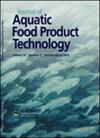Optimization of Pigment Extraction from Aristeus alcocki Shell Wastes via Different Solvent Systems
IF 1.3
4区 农林科学
Q4 FOOD SCIENCE & TECHNOLOGY
引用次数: 0
Abstract
ABSTRACT Arabian deep-sea red shrimp Aristeus alcocki is considered to be an ideal source of pigments, especially astaxanthin, and its analogs. Extraction of pigments from exoskeleton discards of A. alcocki was analyzed by using organic solvents, namely, n-hexane, acetone, ethyl acetate, methanol, and ethanol under cold and hot conditions. A significantly greater pigments yield was obtained using acetone: methanol (1:1 v/v) (10.4-10.9%) and ethanol (9.3-9.7%) extractions compared with conventional acetone extract (7.4-8.1%) (p < 0.05). Chromatographic experiments with the pigment extracts showed the presence of free astaxanthin, astaxanthin mono-ester, and astaxanthin di-ester. GRAPHICAL ABSTRACT不同溶剂体系对黄芪壳废液中色素提取工艺的优化
摘要阿拉伯深海红虾Aristeus alcocki被认为是一种理想的色素来源,尤其是虾青素及其类似物。采用有机溶剂,即正己烷、丙酮、乙酸乙酯、甲醇和乙醇,在冷热条件下对A.alcocki外骨骼废弃物中色素的提取进行了分析。与传统的丙酮提取物(7.4-8.1%)相比,使用丙酮:甲醇(1:1 v/v)(10.4-10.9%)和乙醇(9.3-9.7%)提取物获得了显著更高的色素产量(p<0.05)。用色素提取物进行的色谱实验显示存在游离虾青素、虾青素单酯和虾青素二酯。 图形摘要
本文章由计算机程序翻译,如有差异,请以英文原文为准。
求助全文
约1分钟内获得全文
求助全文
来源期刊
CiteScore
3.50
自引率
6.20%
发文量
77
审稿时长
7 months
期刊介绍:
The Journal of Aquatic Food Product Technology publishes research papers, short communications, and review articles concerning the application of science and technology and biotechnology to all aspects of research, innovation, production, and distribution of food products originating from the marine and freshwater bodies of the world. The journal features articles on various aspects of basic and applied science in topics related to:
-harvesting and handling practices-
processing with traditional and new technologies-
refrigeration and freezing-
packaging and storage-
safety and traceability-
byproduct utilization-
consumer attitudes toward aquatic food.
The Journal also covers basic studies of aquatic products as related to food chemistry, microbiology, and engineering, such as all flora and fauna from aquatic environs, including seaweeds and underutilized species used directly for human consumption or alternative uses. Special features in the journal include guest editorials by specialists in their fields and book reviews covering a wide range of topics.

 求助内容:
求助内容: 应助结果提醒方式:
应助结果提醒方式:


